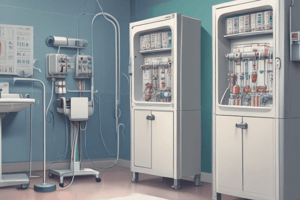Podcast
Questions and Answers
What is the typical rate of blood flow during hemodialysis?
What is the typical rate of blood flow during hemodialysis?
- 200-800 mL/minute (correct)
- 1000-1500 mL/minute
- 800-1000 mL/minute
- 100-200 mL/minute
Which of the following access types is associated with a high risk of hematoma and pneumothorax?
Which of the following access types is associated with a high risk of hematoma and pneumothorax?
- Subclavian catheter (correct)
- Fistula
- Graft
- Femoral catheter
What is the primary purpose of exercising the vessels after fistula creation?
What is the primary purpose of exercising the vessels after fistula creation?
- To reduce the risk of thrombosis
- To promote healing
- To increase the size of the vessels (correct)
- To reduce the risk of infection
Which type of vascular access is typically used for patients with compromised vascular systems?
Which type of vascular access is typically used for patients with compromised vascular systems?
How long does it typically take for a fistula to mature before it can be used for hemodialysis?
How long does it typically take for a fistula to mature before it can be used for hemodialysis?
What is a major advantage of arteriovenous grafts in hemodialysis?
What is a major advantage of arteriovenous grafts in hemodialysis?
What is a potential complication of hemodialysis that can occur if air enters the vascular system?
What is a potential complication of hemodialysis that can occur if air enters the vascular system?
What is a contraindication for hemodialysis?
What is a contraindication for hemodialysis?
What is a symptom of dialysis disequilibrium?
What is a symptom of dialysis disequilibrium?
What is a potential cause of dysrhythmias during hemodialysis?
What is a potential cause of dysrhythmias during hemodialysis?
Flashcards are hidden until you start studying
Study Notes
Hemodialysis
- Hemodialysis is the process of removing metabolic waste and water from blood using a semipermeable membrane of an artificial kidney.
- Vascular access to the patient's vascular system must be established to allow blood to be removed, cleansed, and returned to the patient's vascular system at rates between 200 and 800 mL/minute.
Types of Vascular Access
- Immediate access to the patient's circulation for acute hemodialysis can be achieved by inserting a double-lumen or multilumen catheter into the subclavian, internal jugular, or femoral vein.
- Risks involved with this method include hematoma, pneumothorax, infection, thrombosis of the subclavian vein, and inadequate flow.
- A more permanent access, known as a fistula, is created surgically by joining an artery to a vein, either side to side or end to side, usually in the forearm.
- Fistula takes 4 to 6 weeks to mature before it is ready for use.
- Exercises can be performed to increase the size of these vessels, such as squeezing a rubber ball for forearm fistulas.
- An arteriovenous graft is created when the patient's vessels are not suitable for a fistula.
- Grafts are usually placed in the forearm, upper arm, or upper thigh.
- Infection and thrombosis are the most common complications of arteriovenous grafts.
Indications of Hemodialysis
- Hemodialysis may be used in the treatment of both acute and chronic renal failure.
- The procedure is usually carried out three times a week.
- Other indications include uncontrolled hyperkalemia, fluid overload, peritonitis, and severe acidosis.
Contraindications
- Sever hemodynamic instability.
- Acute and severe bleeding.
- Intolerance to systemic heparinization.
Advantages and Disadvantages
- Advantages: more efficient, faster process, can be used for temporary or permanent dialysis, shorter time for treatment needed (3-4 hours, 3-4 times a week).
- Disadvantages: requires trained personnel and sophisticated equipment, requires heparinization, requires maintenance of vascular access, expensive to maintain.
Complications of Hemodialysis
- Hypotension may occur during the treatment as fluid is removed, accompanied by symptoms such as nausea, vomiting, diaphoresis, tachycardia, and dizziness.
- Painful muscle cramping may occur, usually late in dialysis as fluid and electrolytes rapidly leave the extracellular space.
- Exsanguination may occur if blood lines separate or dialysis needles accidentally become dislodged.
- Dysrhythmias may result from electrolyte and pH changes or from removal of antiarrhythmic medications during dialysis.
- Air embolism is rare but can occur if air enters the vascular system.
- Chest pain may occur in patients with anemia or arteriosclerotic heart disease.
- Dialysis disequilibrium results from cerebral fluid shifts, with signs and symptoms including headache, nausea and vomiting, restlessness, decreased level of consciousness, and seizures.
Studying That Suits You
Use AI to generate personalized quizzes and flashcards to suit your learning preferences.




